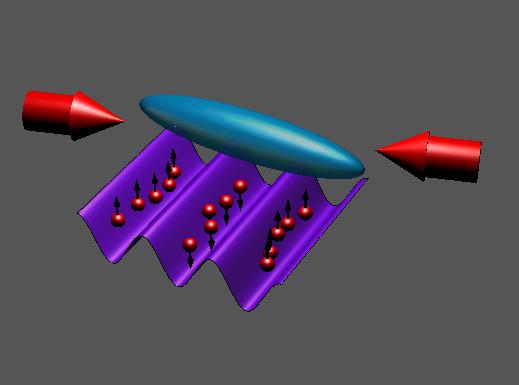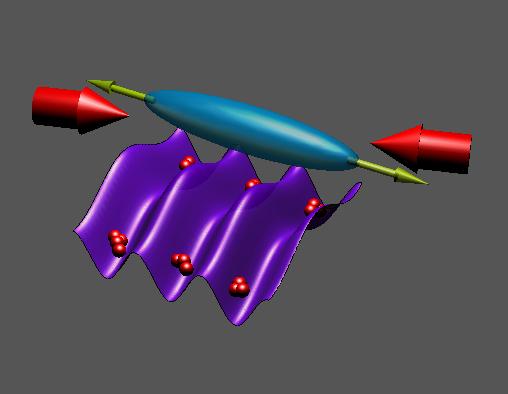Cooperation is key:
Super-charging nonlinear optical processes
Super-charging nonlinear optical processes
Summary
Light-based technologies, like fiber optics, have revolutionized how we communicate and receive information. In order to push optical information networks to their fundamental quantum limit, we require the capacity to control the degree to which light and matter interact (even down to the most fundamental, quantum level). To this end, I am looking into new ways to prepare matter (in my case, a gas of atoms) so that incident photons (light particles) interact with the matter with a controllable strength. More specifically, I am investigating new schemes that enable atoms to scatter light in a cooperative manner in order to "super charge" the nonlinear optical interaction between light and matter in a controllable way.
The first step in my experiment involves the creation of a cigar-shaped cloud composed of billions of slow-moving, ultra-cold rubidium atoms using a magneto-optical trap (MOT). Unlike in a solid, where atoms are locked in position, atoms in the cloud are able to move around freely in response to external forces. Initially, the atoms are randomly distributed spatially throughout the cloud (see left panel ). When I shine a pair of laser beams on the atoms, some of the light reflects off the atoms, giving them a kick that alters their location (see middle panel). Both the applied laser beams and the scattered light affect the positions of the atoms, giving rise to a feedback mechanism that causes the atoms to self-assemble into a spatially-organized configuration (see right panel). Because this configuration is influenced by both the incident and scattered light, it is just right to allow the atoms to cooperate to maximize nonlinear optical (light-matter) interactions.
The cool result is that I observe new, intense beams of light generated by the interaction that are emitted along the long-dimension of the cigar-shaped cloud of atoms (shown as the yellow arrow in the right panel). In addition, because the light acts to effectively hold the atoms in place, the coherence time (time over which the atoms remain in a given quantum state) is greatly extended. This means that any information imparted to the atoms by the light will remain stored in the sample for a longer time, thus making this system a potential candidate for a quantum memory.
References
- D. Gauthier, B. Schmittberger, and J. Greenberg, "Transverse Optical Patterns for Low-light-level Optical Switching," in Nonlinear Optics, B. Boulanger, S. Cundiff, M. Kauranen, and W. Knox, eds., OSA Technical Digest (online) (Optical Society of America, 2013), paper NTh2A.1.
- J.A. Greenberg, 'Collective Light-matter Interactions via Emergent Order in Cold Atoms,' Duke University Ph.D. Dissertation, unpublished (2012)
- J.A. Greenberg and D.J. Gauthier, “Steady-state, cavity-less, multimode superradiance,” Phys. Rev. A 86, 013823 (2012).
- J.A. Greenberg and D.J. Gauthier, “High-order optical nonlinearity at low light levels,” EPL 98 24001 (2012)
- D. Gauthier and J. Greenberg, "Toward Single-Photon Nonlinear Optics via Self-Assembled Ultracold Atoms," in Frontiers in Optics 2010/Laser Science XXVI, OSA Technical Digest (CD) (Optical Society of America, 2010), paper LTuB1.
- J.A. Greenberg, B.L. Schmittberger, and D.J. Gauthier, “Bunching-induced optical nonlinearity and instability in cold atoms [Invited],” Opt. Express 19, 22535 (2011).
- J. Greenberg and D. Gauthier, "Self-Phase Matched Four-Wave Mixing in Cold Vapor," in Frontiers in Optics, OSA Technical Digest (CD) (Optical Society of America, 2010), paper FWZ2.
- J.A. Greenberg and D.J. Gauthier, Superradiance in an Ultracold Thermal Vapor, in OSA Optics and Photonics Congress Technical Digest (2009)
- J.A. Greenberg and D.J. Gauthier, Transient dynamics and momentum redistribution in cold atoms via recoil-induced resonances, Phys. Rev. A (2009)
- J. A. Greenberg, M. Oria, A. M. C. Dawes, and D. J. Gauthier, Absorption-induced trapping in an anisotropic magneto-optical trap, Optics Express, vol. 15 (2007), pp. 17699
- Quantum Electronics Lab ~ Duke University Physics Department ~ Fitzpatrick Institute for Photonics




